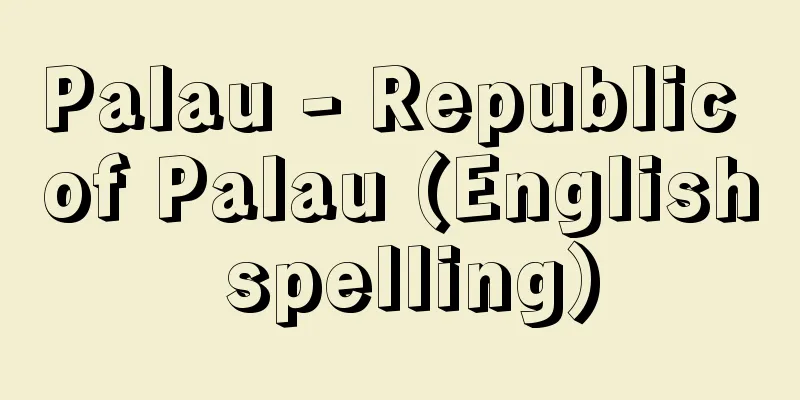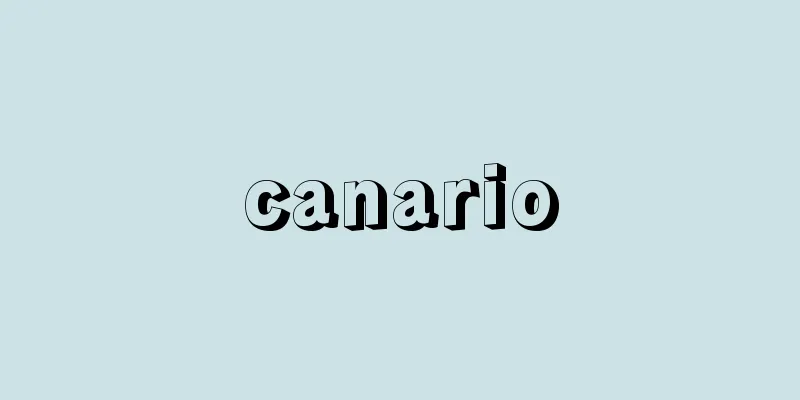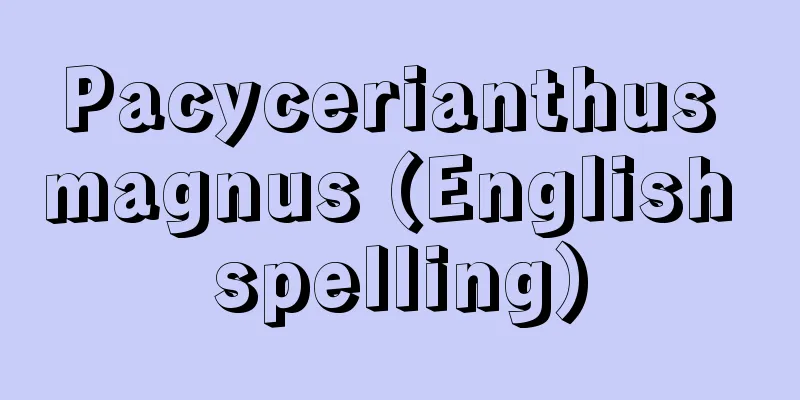Palau - Republic of Palau (English spelling)

|
An island nation located 820 km east of the Philippines, at the westernmost tip of Micronesia. Its official name is the Republic of Palau. Its land area is 459 square kilometers, almost the same size as Yakushima. It was once part of the South Seas Islands under Japanese rule, and the South Seas Bureau was located there during the Japanese rule (1922-1945). The republic, with a population of 22,000 (estimated in 2006) and 20,397 (World Bank, 2009), achieved independence in 1994, the latest among the United Nations Trust Territories of Micronesia. Since independence, it has become well known in Japan as a resort destination, second only to the US territories of Guam and Saipan. The capital is Melekeok, which was moved from Koror in October 2006. [Izumi Kobayashi] Nature and GeographyThe lagoon (the inner sea area or lagoon of a coral reef) surrounding the main island Babeltaap (Babeldaob) is dotted with over 200 islands, large and small, called rock islands, creating a fantastic landscape. The Japanese once called this place Palau Matsushima. The main island, with an area of 331 square kilometers, is the third largest in Micronesia after Guam and Pohnpei. In addition to the beautiful marine scenery, the highest peak in the center of the island reaches 230 meters above sea level, making the topography very varied and the flora rich. Most of the inhabitants live on the flat land along the coast, but on the hills and in the middle of the hills there are remains of habitations estimated to date back 600 to 1200 years ago. Micronesians in the Western Caroline Islands were considered to be of Mongoloid race, but there was a great deal of variation, and the inhabitants of the Palau Islands showed a mixture of Melanesian features, such as dark skin, curly or wavy hair, and broad noses. Archaeological research has confirmed cultural influence from Indonesia in the 7th and 8th centuries, and settlement remains have been found that date back even further, to before Christ. It has a tropical maritime climate with an average annual temperature of 27.9°C, humidity of 82%, and high annual rainfall of 3,800 mm. The dry season is from November to April, and the rainy season is from May to October, but in recent years, perhaps due to the effects of climate change, the distinction between the two has become unclear. [Izumi Kobayashi] historyIt is said that the first person to come to the islands was the Englishman Francis Drake, who began trading in 1579. In 1783, the British merchant ship Antelope ran aground near Koror and was rescued by Koror's chief, Ibador. This marked the beginning of active exchanges with Westerners, leading to the influx of muskets, gunpowder, and alcohol. As a result, fighting intensified between the southern village alliance centered on Koror and the northern village alliance centered on Melekeok. This conflict between the north and south continued for nearly 100 years until a North-South Peace Agreement was signed in 1883 with the mediation of the UK. Spain claimed the territory in 1885, but after losing the Spanish-American War in 1899, it sold it to Germany. In 1914, when World War I broke out, Japan occupied German Micronesia, including Palau, and in 1920 it was recognized as a mandated territory by the League of Nations. Japan called the Micronesian region, from the Marshall Islands in the east to Palau in the west and the Mariana Islands in the north, the South Seas Bureau, which served as the administrative center of the region, located in Koror, Palau. As a result, Palau, along with Saipan, the closest island to Japan, saw an influx of many Japanese (Japanese living overseas) and economic development. Japanization of the local residents was also promoted through the teaching of Japanese language to local residents and the construction of shrines. As of 1940, the population was 6,587 Palauans and 23,767 Japanese. After independence, several Japanese presidents and ministers emerged, all of whom were descendants of Japanese men who married Palauan women at that time. In 1945, after Japan lost the Pacific War, all Japanese in Palau were forced to leave by the American occupation forces. In 1947, the former South Sea Islands became a United Nations (UN) Trust Territory under American administration, and the United States removed all Japanese influence, while vigorously encouraging the local people to learn English and instilling American-style democracy in them. Negotiations with the United States began in 1969 regarding the political status of the islands after the end of the trusteeship. Initially, the Trust Territory of Micronesia aimed to achieve autonomy or independence for the whole of the islands, but in 1977, Palau held a referendum to withdraw from the regional state concept, established its own constitution, and launched an autonomous government in 1981. It took 13 years until independence was achieved in 1994 under a free association with the United States, due to domestic political turmoil, including repeated referendums over the construction of favorable relations with the United States. [Izumi Kobayashi] PoliticsThe government is a republic modeled on the American system. The president and vice president are elected separately for four-year terms. In 2008, the system was changed to a pair of president and vice president, but the constitution was amended to return to the original system for the 2012 elections. The cabinet is made up of ministers appointed by the president. The parliament is bicameral, with the Senate's constituencies and seats determined by the Apportionment Committee (14 seats as of 2011). The lower house is elected by one member from each of the 16 states, with a four-year term. In Palau, the traditional village structure is carried over to the states, and there is a National Council of Chiefs, made up of one traditional chief from each state, which serves as an advisory body that advises the president based on traditional laws and customs. Although traditional chiefs do not have real political power, they still wield great political and social authority. The symbol of this is seen in the two chiefdoms of the "Aibador" of Koror and the "Alkurai" of Melekeok, who represent the north and south of Palau respectively. The greatness of their traditional authority is also shown in the fact that they always attend important national ceremonies with the same rank as the president. After the autonomous government was established, domestic politics were in turmoil, with the assassination of the first president, but the political turmoil was put to an end by the fourth president, Kuniwo Nakamura (1943-2020, in office 1993-2001). Negotiations for the Compact of Free Association with the United States were also concluded, and the requirements for independence were finally met in 1994. Nakamura served as president for two terms, eight years, the limit set by the constitution. Domestic politics since then have progressed without much turmoil, although there have been political infighting. [Izumi Kobayashi] Compact of Free Association"The Freely Associated States will retain sovereignty under their constitutions, but the United States will retain full authority and responsibility for defense and security. At the same time, the United States will provide financial assistance for a period of 15 years." This is the gist of the agreement concluded between the three Micronesian nations (Palau, the Federated States of Micronesia, and the Marshall Islands) and the United States, but in the case of Palau, a separate supplementary agreement states that "the United States will secure military rights to certain land and water areas for 50 years," and that the contents of the agreement will be reviewed every 15, 30, and 50 years. However, the agreement itself can be freely dissolved by either side. This is where the name "Freely Associated" comes from. [Izumi Kobayashi] Economy and SocietyThe country's finances are based on compact money from the United States. The total amount of compact money received in the 15 years since independence is about 450 million dollars. In 2010, the second financial assistance agreement was signed, and a promise of 250 million dollars over the next 15 years was obtained. In addition, Japan and Taiwan have also provided a lot of aid. Thus, the country remains highly dependent on the public sector, but as infrastructure is improved, foreign capital for tourism development has begun to flow in. This is because the country has beautiful natural scenery and is geographically advantageous, being close to the densely populated Asian region. The number of tourists per year exceeded 80,000 in 2008, and the country is establishing itself as a resort destination. The per capita GNI (gross national income) is $8,940 (2009), which is by far the highest among the Micronesian countries. However, to maintain this level even after the end of aid, the country must move away from the public economy, where 30% of the working population is engaged in government-related work. The government's vision for the future is industrialization through tourism and fishing. The currency used is the US dollar. The Palauan language and English are spoken, and most people are Christian, but the chieftaincy system remains, and the underlying culture is based on the tradition of a matrilineal society in which property and titles are passed down through the female line of descendants. The government's goal of industrializing the society depends on how well it can incorporate the advantages of American individualism into a social structure with strong ties to kinship groups. The education system consists of eight years of primary education and four years of secondary education, with Palauan and English used as the languages of instruction at the primary level, and English at the secondary level and above. The primary education enrollment rate is 90%. The country's higher education institution is the two-year Palau Community College in Koror, which offers courses in nursing and teacher training, vocational training, agriculture, criminal law, and more. Those seeking a full-fledged university education can obtain scholarships to attend universities in Guam, Hawaii, or the US mainland. The rate at which citizens go on to higher education is around 20%. [Izumi Kobayashi] Relations with Japan2012 marks 67 years since the end of the Pacific War, and almost no Japanese-speaking generations remain, but Japanese influence remains strong in everyday language and cuisine. Bento, undokai, and janken have become localized in the Palauan language, and sushi rolls and pickles have also become indigenous. There are many Palauans of Japanese descent, and more than 20% of all Palauans have Japanese blood. Memorial services from Japan continue to this day on Peleliu Island, where the Japanese military "fought annihilated," and Angaur Island. Relations have remained extremely good since independence, with many tourists visiting from Japan, construction of the 432-meter-long Japan-Palau Friendship Bridge connecting Koror and the main island, and Japan's ODA (Official Development Assistance) contributions totaling 22.456 billion yen as of 2009. In 1999, Palau opened its embassy in Tokyo, and Japan opened a resident office in Koror, which was upgraded to an embassy in 2010 and dispatched an ambassador to the country. [Izumi Kobayashi] "Palau Undersea Guidebook" by Ryoichi Sato (2003, Hankyu Communications) [References] | | | | | | | [Additional information] |"> Palau flag ©Shogakukan Illustration/Shogakukan Creative "> Palau Location Map This is an area of sea dotted with over 200 islands, large and small. The photo shows a strange rock formation known as a natural arch, which is one of the scenic spots. Part of the World Heritage Site "Rock Islands of the Southern Lagoon" (Palau, registered in 2012) Koror State, Palau ©Shogakukan "> Rock Island Source: Shogakukan Encyclopedia Nipponica About Encyclopedia Nipponica Information | Legend |
|
ミクロネシアの最西端、フィリピンの東820キロメートルに位置する島嶼(とうしょ)国家。正称パラオ共和国Republic of Palau。屋久島(やくしま)とほぼ同じ大きさの国土459平方キロメートルを有する。かつて日本が統治していた南洋群島の一部で、日本統治時代は南洋庁が置かれていた(1922~1945)。人口2万2000(2006年推計)、2万0397(2009年、世界銀行)の共和国は、国連(国際連合)の信託統治領ミクロネシアのなかではもっとも遅い1994年に独立を果たした。独立後は、アメリカ領のグアム、サイパンに次ぐリゾート地として日本でも知名度が上がっている。首都はマルキョクで、2006年10月にコロールより遷都した。 [小林 泉] 自然・地誌本島バベルツアプ(バベルダオブ)を囲むラグーン(サンゴ礁などの内側の海域・礁湖)の中には、ロックアイランドとよばれる大小200以上もの島々が散りばめられ、幻想的な景観をつくりだしている。かつて日本人は、ここをパラオ松島とよんだ。面積331平方キロメートルの本島は、ミクロネシアのなかではグアム島、ポンペイ島に次いで三番目に大きい。海洋景観の美しさに加えて島中央の最高峰は海抜230メートルにも及ぶので地形は変化に富み、植物相も豊かである。住民の大半は海岸沿いの平地に住んでいるが、高台やその中腹には600年から1200年前のものと推定される先人の居住跡が残っている。 西カロリン諸島のミクロネシア人はモンゴロイド人種とみなされていたが、変異も大きく、パラオ諸島の住民は色黒、縮れ毛もしくは波状毛、広鼻などメラネシア人的特徴が混じっている。考古学的研究によれば7、8世紀にはインドネシア方面からの文化的影響が認められ、さらにさかのぼって紀元前とも推定される居住遺跡がみつかっている。 熱帯海洋性気候で年間平均気温は27.9℃、湿度82%で降雨量も年間3800ミリメートルと多い。11~4月が乾期、5~10月が雨期とされているが、近年では気候変動の影響からかその区別が明確でなくなってきている。 [小林 泉] 歴史1579年、イギリス人フランシス・ドレークが来島し交易を始めたのが最初だといわれる。1783年にイギリス商船アンテロープ号がコロール付近で座礁、これをコロールの酋長(しゅうちょう)アイバドールが救助した。これが端緒となり西洋人との交流が盛んになると、マスケット銃や火薬、酒などが流入した。それにつれてコロールを中心にした南部村落連合とマルキョク中心の北部村落連合の戦いが激化していった。この南北対立は、イギリスの仲裁で南北和平協定が結ばれる1883年まで100年近く続いた。 1885年にはスペインが領土宣言、しかし1899年には米西戦争に敗れてドイツに売却した。第一次世界大戦が勃発(ぼっぱつ)した1914年、日本はパラオを含むドイツ領ミクロネシアを占領し、1920年に国際連盟の委任統治領として認められた。日本は、東はマーシャルから西はパラオ、北はマリアナ諸島までのミクロネシア地域を南洋群島と称し、その統治行政の中心となる南洋庁をパラオのコロールに置いた。そのためパラオは、日本からもっとも近いサイパンとともに多くの邦人(海外居住日本人)が流入して経済も発展した。現地住民への日本語教育や神社の建立などの日本化も進めた。1940年時点での居住者人口は、パラオ人6587人に対し邦人は2万3767人を数えた。独立後、複数の日系人大統領や大臣が出現しているが、彼らはこのときにパラオ人女性と結婚した日本人男子らの子孫である。 1945年に日本が太平洋戦争に敗戦、アメリカ占領軍の手でパラオの邦人はすべて強制退去させられた。1947年に旧南洋群島がアメリカ施政下の国連(国際連合)信託統治領になると、アメリカは日本的影響をことごとく排除する一方、地元民に英語を身につけさせ、アメリカ式民主主義を植えつける統治を熱心に行った。信託統治終了後の島々の政治地位について、アメリカとの交渉が始まったのが1969年である。当初、信託統治領ミクロネシアは、全体で自治または独立を目ざす方針が立てられたが、パラオは1977年に住民投票で地域国家構想からの離脱を決めて独自憲法を制定、1981年に自治政府を発足させた。それからアメリカとの自由連合関係の下で1994年に独立するまで、13年の歳月を費やしたのは、有利な対米関係の構築をめぐって何度も住民投票を繰り返すなど国内政治に混迷が生じたからであった。 [小林 泉] 政治政体はアメリカの制度を参考にした共和制。4年任期の正副大統領は別々に選出される。2008年から正副大統領のペア制に変わったが、憲法改訂により2012年の選挙からふたたび元の制度にもどった。内閣は大統領が指名した大臣で構成する。議会は二院制で、上院は議席配分是正委員会によって選挙区と議席が定められる(2011年時点での議席数は14)。下院は16州から1人ずつ選出され、任期は4年である。パラオでは、伝統的な村落の枠組みがそのまま州に引き継がれており、州に1人いる伝統的酋長たちで構成する全国酋長評議会があり、これが伝統的な法や慣習に基づいて大統領に助言する諮問機関になっている。伝統酋長職は、政治的実権はないものの、政治・社会的権威はいまだに大きい。その象徴がパラオの南北をそれぞれ代表するコロールの「アイバドール」とマルキョクの「アルクライ」による二大酋長制にみられる。国家的な重要式典では、必ず大統領と同格で列席するところにも伝統権威の大きさが表れている。 自治政府の発足後、初代大統領が暗殺されるなど国内政治は混迷をきわめたが、4代目大統領クニオ・ナカムラKuniwo Nakamura(1943―2020、在任1993~2001)により政治混乱も終息した。アメリカとの自由連合協定にかかわる交渉にも決着がつき、1994年にようやく独立への要件が整った。ナカムラは憲法で定める限度の2期8年間大統領を務めた。その後の国内政治は、政争はあるもののそれほどの混乱に陥ることなく推移している。 [小林 泉] 自由連合協定Compact of Free Association「自由連合国は、憲法の下に主権を有するが、防衛と安全保障についてはアメリカが全面的権限と責任を負う。同時に、アメリカは15年間にわたり財政支援を行う」。これが、ミクロネシア三国(パラオ、ミクロネシア連邦、マーシャル諸島)がアメリカと結んだ協定の骨子であるが、パラオについては付帯別協定のなかで、「アメリカは一定の土地、海域の軍事利用権を50年間確保する」とあり、協定内容は15年、30年、50年ごとに再検討するとされている。ただし、協定自体はどちらか一方の意思で自由に解消ができる。それが自由連合の名称由来である。 [小林 泉] 経済・社会財政は、アメリカからの協定援助金(コンパクトマネー)を基本に成り立っている。独立後15年間に受領したコンパクトマネー総額は約4億5000万ドル。2010年には、第二次財政支援協定を結び、今後15年間で2億5000万ドルの供与を受ける約束を取り付けた。そのほか、日本や台湾からの援助も少なくない。このように公的部門への依存度は依然として高いが、インフラが整うにつれて観光開発のための外国資本が流れ込むようになった。美しい自然景観と人口が密集するアジア地域に近いという地理的有利性を備えているからである。年間観光客は2008年には8万人を超え、リゾート地としての地位を築きつつある。1人当りGNI(国民総所得)は8940ドル(2009)で、ミクロネシア諸国のなかでは群を抜く高さである。しかし、援助終了後もこの水準を維持するには、就労人口の3割が政府関係に従事している公経済体質から脱却しなくてはならない。政府が描く将来展望は観光業、漁業による産業化にある。使用通貨はアメリカ・ドル。 言語はパラオ語のほかに英語を話し、宗教はほとんどがキリスト教徒であるが、酋長制度が残存しているように、基層文化は女性子孫の系列で財産や称号が継承される母系制社会の伝統が息づいている。政府が目ざす産業化社会の実現は、親族集団の結びつきが強い社会構造のなかにアメリカ式個人主義による利点をいかにうまく取り込むかにかかっている。 教育制度は初等教育が8年、中等教育が4年で、教育言語は初等レベルではパラオ語と英語、中等レベル以上は英語が使用されている。初等教育の就学率は90%。国内の高等教育機関として、コロールに2年制のパラオコミュニティーカレッジがあり、看護師・教員養成コースや職業訓練、農業、刑法などのコースが設置されている。本格的な大学教育を求める者は、奨学金を得てグアムやハワイ、アメリカ本土の大学に進学する。国民の高等教育への進学率は約20%。 [小林 泉] 日本との関係2012年で太平洋戦争後67年が経過し、日本語を話す世代はほとんどいなくなったが、日常の言葉や料理に日本の影響が色濃く残っている。ベントウ、ウンドウカイ、ジャンケンは現地語化し、巻き寿司や漬物も土着化した。日系人も多く、全パラオ人の2割強に日本人の血が流れている。日本軍「玉砕」の島となったペレリュー(ペリリュー)島やアンガウル島への日本からの慰霊行為はいまも続いている。 独立後の関係もきわめて良好で、日本から多くの観光客が訪れるほか、コロールと本島を結ぶ全長432メートルの日本・パラオ友好の橋をはじめ、日本のODA(政府開発援助)拠出は2009年(平成21)までの累積で224.56億円にのぼる。1999年(平成11)にパラオは東京に在日大使館を開設、日本もコロールに駐在官事務所を開設し、2010年には大使館に昇格させて大使を派遣した。 [小林 泉] 『佐藤良一著『パラオ海中ガイドブック』(2003・阪急コミュニケーションズ)』 [参照項目] | | | | | | | [補完資料] |"> パラオの国旗 ©Shogakukan 作図/小学館クリエイティブ"> パラオ位置図 大小200以上もの島々が点在する海域。写真はナチュラルアーチとよばれる奇岩で、名勝の一つとなっている。世界複合遺産「南ラグーンのロックアイランド群」の一部(パラオ・2012年登録) パラオ コロール州©Shogakukan"> ロックアイランド 出典 小学館 日本大百科全書(ニッポニカ)日本大百科全書(ニッポニカ)について 情報 | 凡例 |
>>: Palaung people - Palaung (English spelling)
Recommend
sarcoidosis
Sarcoidosis is a systemic disease characterized by...
Indonesian Art - Indonesian Art
Indonesian culture dates back to the BC era, and i...
Warwick, D.
…He won an Academy Award in 1969 for the original...
Return - Kikan
A term used in control engineering and communicati...
The Kan'ei Famine
The first major famine of the Edo period was cause...
National Income - kokuminshotoku
NI stands for national income. It is the sum of go...
T-square - T-square
A T-shaped drafting ruler. The T-shaped part is fi...
Bemberg rayon (English spelling)
…Thiele was employed by J.P. Bemberg, and the two...
Grassland - Sochi
Land used primarily for grazing livestock or for h...
Kinaraia tribe
The Ilonggo (also called Hiligaynon; 4.2 million)...
Jerusalem Talmud - Elsalem Talmud
…For a long time, the oral law was transmitted or...
Song of the dead
A type of Chinese folk performing art. In Chinese,...
Alluvial mining
There are deposits containing useful minerals, suc...
molar rotary power
For example, the specific rotation of sucrose at ...
Arab Common Market
ACM is a common market among Arab countries. It w...









